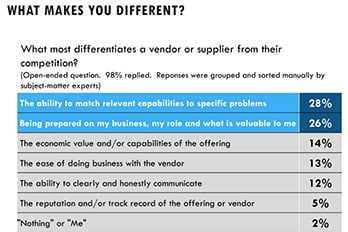
To help sales and marketing understand what it takes to be more competitive, Forrester recently asked an important open-ended question of buyers – What most differentiates a solution provider from their competition?
-
The top three responses reveal how important diagnosis, prescriptions and business-value are to creating differentiation from your competitors:
- 28% – The ability to match relevant capabilities to specific problems
- 26% – Being prepared on my business, my role and what is valuable to me
- 14% – The economic value and capabilities of the offering
The research reinforces once again, rather than pitching a solution, a business value approach focused on the buyer and their unique challenges is essential. If you talk about your solution, it should only be in the context of alignment to specific problems you can address, and the business value you can uniquely deliver.
So how can you best evolve to a business value approach? Here’s how to address each of the top three key differentiators:
How to address? To help the buyer identify issues, you should document specific challenges you see within the accounts you visit, what some of the determining characteristics there are to identify the challenges are manifesting themselves, and
align your solutions around specific challenges and use cases.
This means, educating the seller and buyer about how to recognize when the issue exists, and when prescribed, how your solution specifically alleviates the issue.
Diagnostic assessment tools can help to elevate and automate the diagnosis and alignment process, helping prospects to discover key issues, measure and benchmark the shortfall (versus an absolute capability / maturity score and versus peers), prioritize remediation and intelligently provide automated solution recommendations and alignment.
-
Checkout these EVOLVER Spotlight: Diagnostic Assessment Tool examples:
- Hootsuite Social Media Maturity Assessment – https://www.evolvedselling.com/evolver-spotlight-hootsuite-social-media-maturity/
- Cloud Elements API Integration Capability Assessment – https://www.evolvedselling.com/evolvers-spotlight-cloud-elements-api-integration-capability-assessment/
2) Being prepared on my business, my role and what is valuable to me – Each industry, role and stakeholder has their unique challenges and “point of value”. A generic pitch won’t cut it, so you have to show the buyer how well you understand their challenges, and provide advice aligned with these key industry, role and value dimensions.
How to address? Aligning and publishing industry, buyer-role and value-focused content into vignettes can help.
Rather than producing big decks designed to match each presentation scenario or large white papers, instead think about publishing short stories and insight collections oriented towards each industry being targeted, each role involved in the decision-making process and each challenge they face.
The vignettes can help the buyer and seller quickly find and pivot to the industry, role and challenge content directly applicable to them. Sales enablement / content management automation can prompt and then serve up the right personalized story and create custom presentations and collateral based on pivoting the content around the industry, role and challenge dimensions creates a value story that shows personal understanding.
Because metrics and financials are so important, we’ve worked with companies such as Coupa and OpenText to go one step further. Prior to meeting with prospects, the sellers from these companies put together a customized Financial Peer Comparison report. Financial data and metrics are automatically assessed and benchmarked against industry trends and peers, enabling the seller to provide consultative advice on each key financial data point, demonstrating a clear and differentiated understanding of the industry and valuable performance.
3) The economic value and capabilities of the offering – During times of uncertainty, Frugalnomics reigns, with buyers more risk averse and economic- focused. A pitch about what your solution does is not as valuable as what your solution can do for the prospect.
How to address? You have to clearly communicate and quantify specifics on how you can help the buyer cut costs, do more with less, reduce business risk or capture lost revenue opportunities. Proactively providing a financial justification business case can differentiate your proposal from the competition, as well as from the dozens of other projects vying to punch through locked down budgets.
The best leverage self-service and seller led Business Value Assessments, helping buyers tally the high cost of “do nothing” new, the benefits of the proposed solution and return on investment (ROI) potential.
The best business cases go beyond just the numbers, to include a story about the value – so that everyone within the buying committee can understand not just the economic impact, but how the value aligns to strategy, solves specific challenges in a unique way, and credibly can deliver on the promises – with documented 3rd party proof points and relevant success stories.
Checkout this example of an automated business value assessment tool / interactive ROI calculator from Windstream – https://www.mediafly.com/value-tools-windstream/
The Bottom Line
For most providers, it is getting harder and harder to differentiate just on the basis of your solution. Understanding what buyers view as differentiators is key.
From Forrester’s research, it is clear that business-value approach is best. This includes the ability to diagnose and align solutions, deliver industry, role and value advice, and quantify economic value potential.
Leveraging the right content and tools can help make the diagnosis, prescription and business value assessment easier, whether self-service from your website, or enabling sellers to deliver differentiated engagements.
#Forrester #SalesEnablement #ValueSelling #SalesOptimization #Differentiation #CompetitiveIntelligence #SalesPerformance #ContentMarketing #BuyerEnablement #ProductMarketing #ValueAssessmentTools #DiagnosticAssessment #Benchmarks #PeerComparison #ROICalculator #TCOCalculator #ValueManagement #ValueStory #storytelling #financialjustification

Comments are closed.